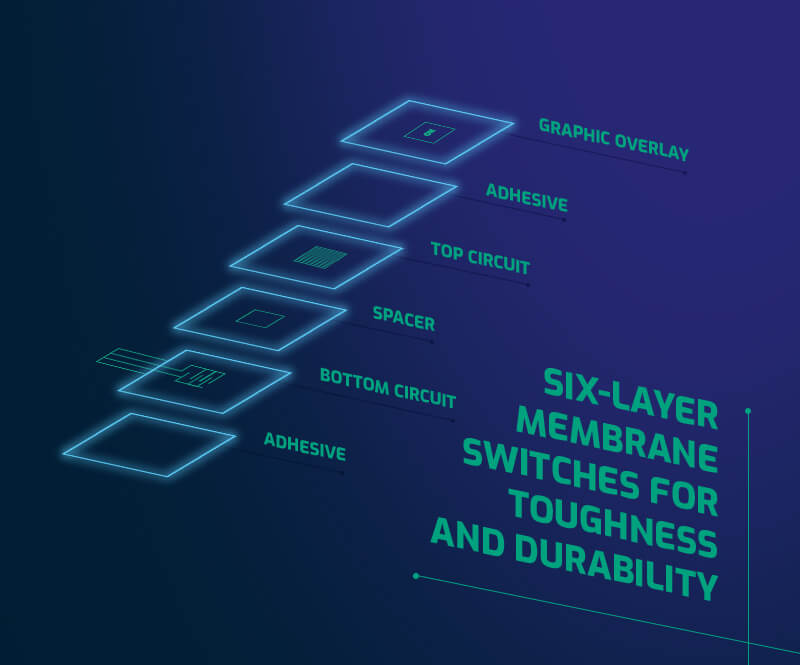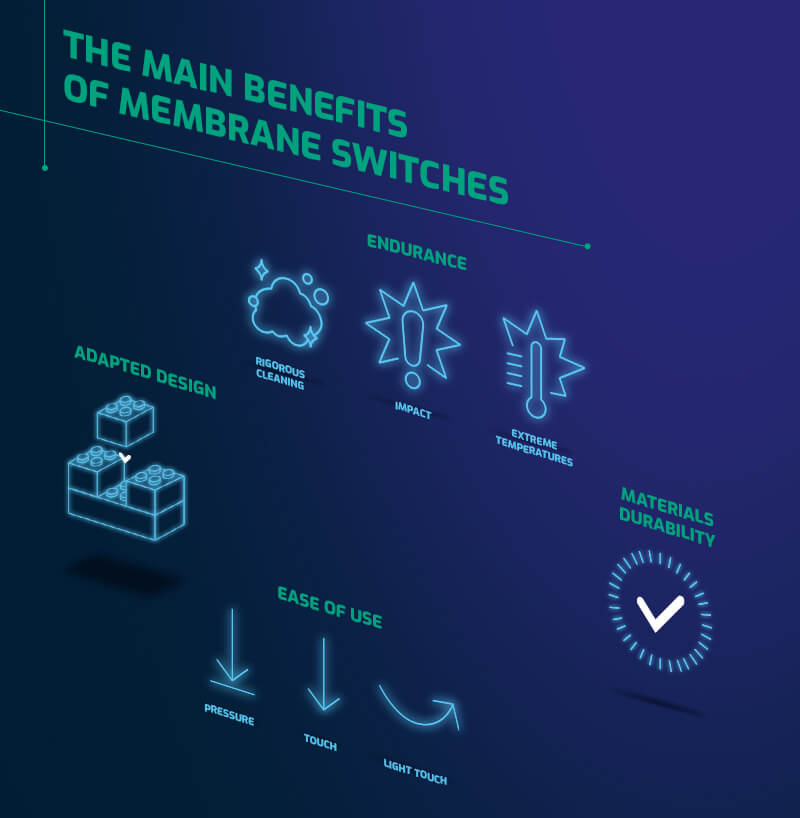HMI technology you can count on
The membrane switch has come a long way since it first appeared on the market. From the simple screen-printed graphic overlay of early days, the membrane switch keypad has developed into a full-blown human-machine interface (HMI) that plays a major role in how we interact with machines. Although the history of the membrane switch hasn’t been without setbacks, today’s components continue to have an important place in world markets.
Despite the arrival of new technologies like the touch screen, the membrane switch is still going strong. After close to 50 years of fine-tuning, the technology is still a mainstay in many sectors on account of its exceptional versatility and durability.
Membrane switches are particularly popular in highly regulated sectors such as the medical and food industries. That’s because they satisfy a variety of requirements in one design: they’re made with durable, impermeable materials that can stand up to stringent cleaning processes—and they’re easy to use.
The introduction of capacitive switches—part touch screen and part keypad—has reaffirmed just how important this technology is on the market. Capacitive keypads, which operate exactly like membrane models, are equipped with sensors allowing users to simply touch the keys, rather than press them. This simple change in the way people and machines interact provides an enhanced experience that users often appreciate.
Four critical functions of your human-machine interface (HMI)
The staying power of membrane switches underscores an important reality in the design of human-machine interfaces (HMI): contrary to what some may think, the best technology is not necessarily the most recent, but rather that which best meets the needs of end users. There has to be a balance between aesthetics, technology, and functionality to deliver an optimal experience.
While the touch screen may be ideal for cellphones and vending machines, it may not be the most desirable option for controlling heavy machinery or adjusting airplane seats. It all depends on how the solution will be used, what it needs to do, and how users perceive it.
That’s why HMI designers develop their products according to the 4 principles of interface design. First and foremost among these principles is the importance of creating a design to meet the needs of the end user. This has a lot to do with the functionalities the interface will have to support. Whether it’s a keypad or a touch screen, it has to be intuitive and free of irritants, and the design needs to leverage the most effective and efficient technology without any unnecessary bells and whistles.
Here is an overview of the 4 principles of interface design. Consult our additional article to learn more.
Given these guidelines, it’s clear that the biggest benefit of modern manufacturing is the diversity of technology available!
These different innovations—from membrane and capacitive switches to mechanical keyboards, touch screens, printed electronics, and others—aren’t in competition; instead, they complement each other, giving you the freedom to select the component best suited to your product.
The experts at Memtronik see this year after year when they walk the aisles at trade shows around the globe. New technologies always turn heads at BIOMEDevice and LOPEC, but the membrane switch still enjoys pride of place. As long as it remains the best solution for dealing with constraints like the need for quick and easy operation, tactile feedback, and resistance to abrasive chemicals, this decades-old technology will continue to be a market staple.
Membrane switch design: The sky’s the limit—almost
What many people like about the touch screen are the virtually infinite possibilities it offers. Behind the screen, you can do just about anything. But the investment required to program this type of interface and install a touch surface isn’t always worth it. When the required functions are simple, as with a microwave oven or defibrillator, all that flexibility can be overkill.
That’s where the membrane switch and its offspring the capacitive switch come into play. In addition to being easy to use, these interfaces offer an impressive range of technical and aesthetic possibilities.
Super thin, light, and adaptable, these keypads can be built into the vast majority of products without any design constraints. Sensors, thermochromic inks, and backlighting are just a few of the features available to improve the user experience. And when it comes to keyboard aesthetics, the sky’s the limit—almost! With so many ink colours and finishes to choose from, you can personalize your keypads to perfectly convey your brand image. The many benefits of this inexpensive solution are hard to beat!
There are so many options to choose from to improve the user experience:
- Fluorescent, metallic, or textured inks
- Backlighting, LED, optical fibers, or electroluminescence
- Sensors for converting the interface into a capacitive keypad
- Glass, plastic, and flexible surfaces
- Custom icons in line with your corporate image
When it comes to membrane switch design, there are virtually no limits—except your imagination!
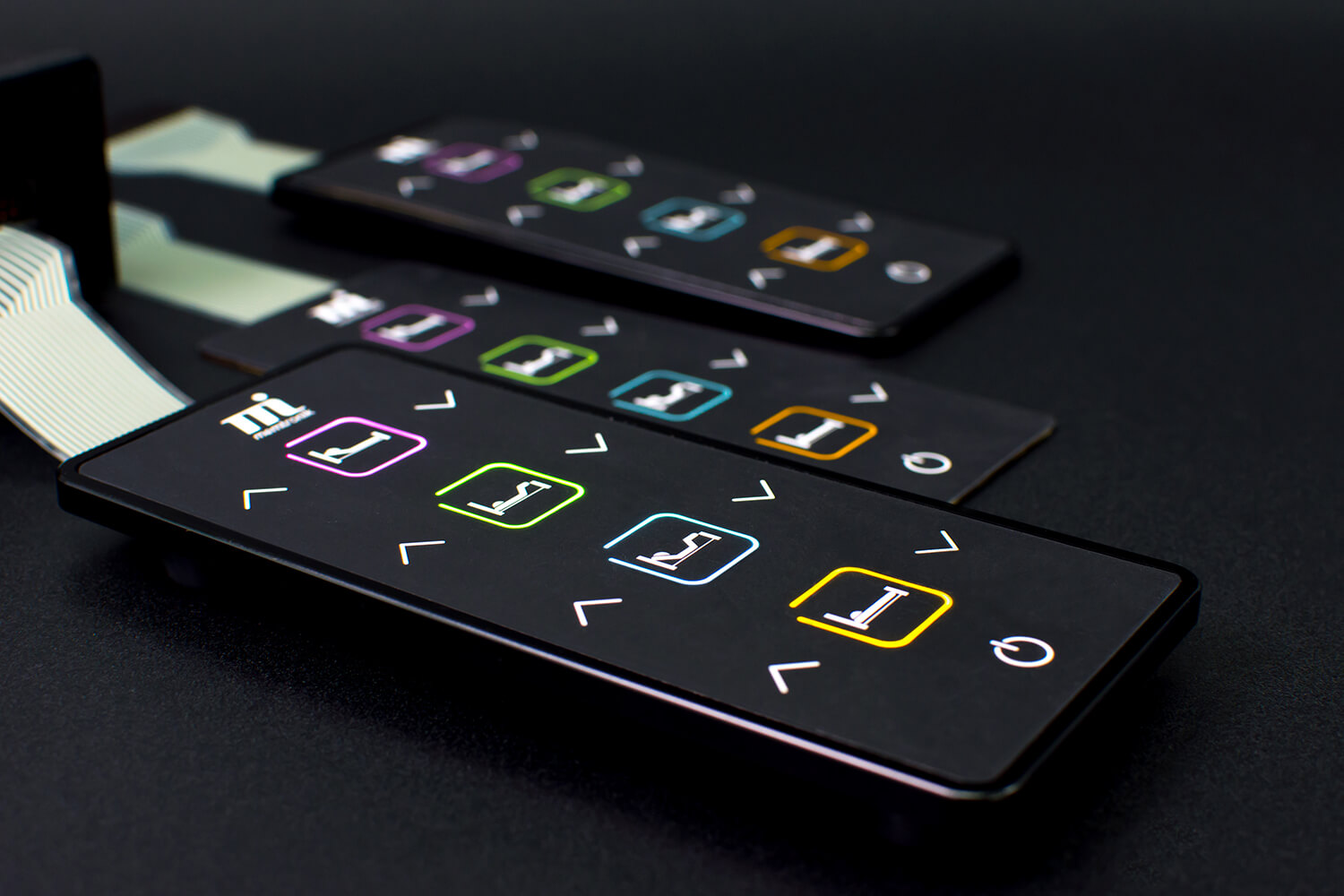
Backlighting
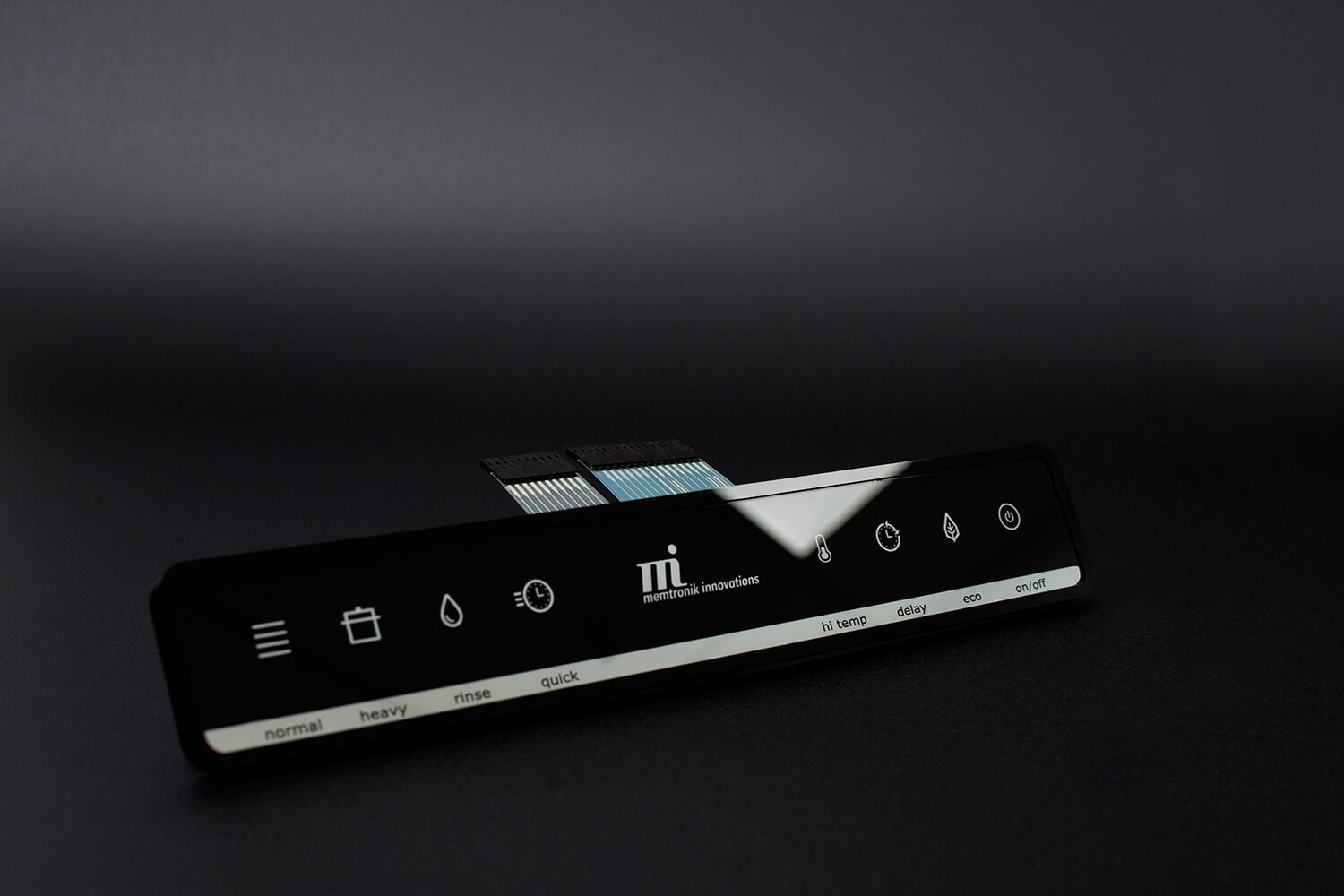
Glass surface
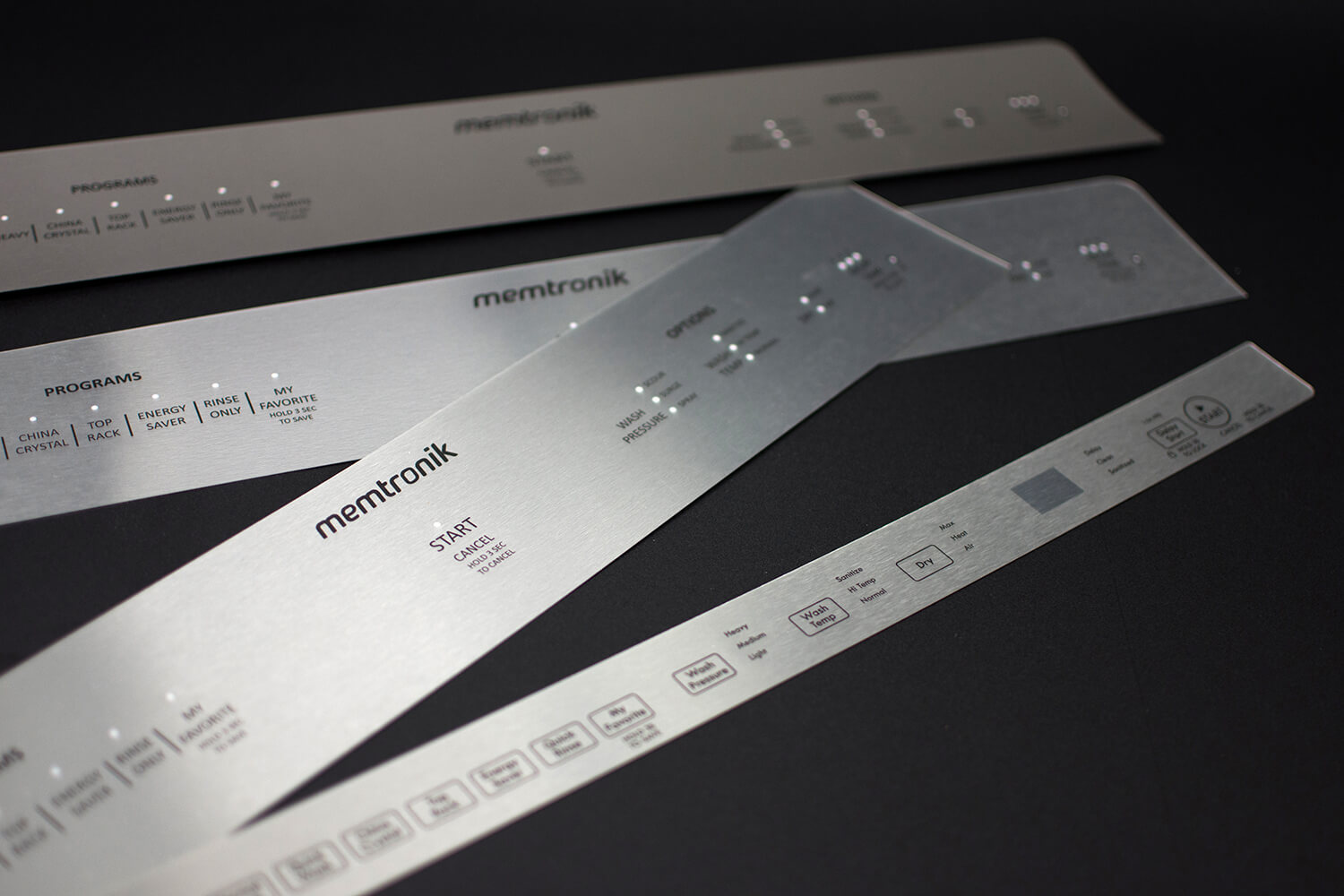
Metallic effect
Six-layer membrane switches for toughness and durability
Their simple design is one of the main reasons why membrane switch keypads are so easy to use with devices of all sizes. A well-designed membrane switch is thin enough to go wherever you need it—whether it’s curved, glass, or metal surface, or where interface space is at a premium. Typical membrane switches feature the following six components.
- Graphic overlay: Visual portion of the interface, with your branding, icons, and designs.
- Adhesive: Our experts have developed a glue printing technique that works wonders!
- Top circuit: Layer with printed circuit boards made from the materials best suited to your needs.
- Spacer: Layer allowing the two circuit layers to create a connection at the press of a key.
- Bottom circuit: A second electronic component that transmits commands.
- Adhesive: Layer that secures the keyboard to the product.
A typical membrane switch has 6 layers, which are assembled to create a thin and durable interface.
Membrane switches, technology that’s built to last
Don’t let the simplicity of these keypads fool you: they’re tough enough to stand up to even the harshest of conditions—provided they’ve been built properly!
From extreme temperatures and humidity to bumps and bangs, repetitive use, and corrosive cleansers, a keypad designed with top-quality polymers can withstand just about anything. That’s one of the main benefits of this technology.
But manufacturing a product able to meet the toughest industry standards requires method and flexibility. That’s why our team always takes an agile approach backed by solid R&D expertise.
The membrane switch user interface is used to perform critical functions in all kinds of industries. There’s no room for error, which is why traceability and quality assurance are so vital to the work we do as membrane switch manufacturers.
An overview of the advantages of membrane switches. Discover more excellent reasons to choose this proven technology by consulting our complementary article: The many benefits of choosing membrane switches.
The ever-changing world of human-machine interfaces (HMI)
In the world of product development, trends, techniques, and technologies evolve at breakneck speed. The latest gadgets barely have time to hit the shelves before they’re outdated.
In a context like this, how can a decades-old component like the membrane switch still be so relevant? Unlike most other technologies, membrane switches are still going strong because they have continuously reinvented themselves to meet users’ changing needs.
When a customer knocks on Memtronik’s door, our experts can’t just slap an existing model onto the customer’s product. Each product interface is unique, which is why our custom membrane switches are crafted to seamlessly integrate with the device design, meet all constraints, and deliver an optimal user experience.
That’s the beauty of what we do. Designing user interfaces means taking part in the cycle of innovation, dreaming up new designs, and tackling ever-changing technical challenges.
Who would have thought that so much information was hidden beneath the surface of such a simple looking component? But make no mistake: building a proper interface takes cutting-edge expertise and state-of-the-art facilities. After all, your membrane switch is the main point of contact between the user and your machine. So it has to be impeccable.
Is membrane switch technology the right choice for you?
This solution is worth considering if you need a human-machine interface that’s:
- Highly reliable
- Compact and thin
- Adapted to your aesthetic and technical needs
- Impermeable and bacteria-resistant
- More affordable than other solutions
- Able to withstand extreme conditions (moisture, heat, cold)
- Able to stand up to intense cleaning processes
- Glove-friendly
- Perfectly on brand
- Built to last
Got questions about membrane or capacitive switch design? Feel free to contact us. Our experts love sharing what they know!


